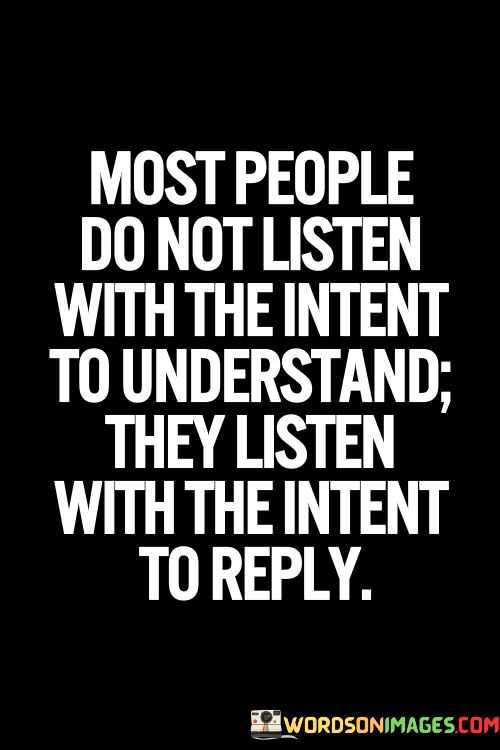The quote, "Most people do not listen with the intent to understand; they listen with the intent to reply," reveals a powerful truth about the nature of communication and the art of active listening. It suggests that in many interactions, people are more focused on formulating their response rather than genuinely seeking to understand the perspectives and emotions of the speaker. This lack of true listening hinders effective communication and genuine connection between individuals. The quote highlights the importance of practicing empathetic and active listening, where the primary goal is to comprehend the speaker's thoughts, feelings, and experiences without judgment or interruption. By adopting a mindset of understanding rather than simply seeking to reply, we foster meaningful and authentic connections with others, nurture empathy and compassion, and create a safe space for open and honest communication. The quote serves as a poignant reminder of the transformative power of listening, encouraging us to cultivate the art of active listening and enhance our ability to truly understand and connect with one another on a deeper and more profound level. At its core, the quote emphasizes the distinction between passive listening and active listening. Passive listening involves merely hearing the words spoken by the speaker without truly internalizing or empathizing with their message. On the other hand, active listening involves giving the speaker our undivided attention, seeking to understand their perspective, and acknowledging their emotions and concerns. Moreover, the quote speaks to the prevalence of self-centered communication patterns in today's fast-paced and digitally connected world. With the constant influx of information and distractions, people often feel compelled to respond quickly and assert their own opinions or experiences rather than pausing to genuinely comprehend what the speaker is trying to convey. Furthermore, the quote underscores the transformative power of empathetic listening in fostering genuine connections and resolving conflicts. When we listen with the intent to understand, we demonstrate respect for the speaker's feelings and validate their experiences. This kind of active listening promotes trust and openness in relationships, paving the way for meaningful and compassionate exchanges. In conclusion, the quote "Most people do not listen with the intent to understand; they listen with the intent to reply" serves as a poignant reminder of the importance of active and empathetic listening in communication. By genuinely seeking to understand the perspectives and emotions of others, we cultivate meaningful connections and create a safe space for open and honest dialogue. The quote encourages us to transcend the self-centered communication patterns that can hinder genuine understanding and empathy, and instead embrace the transformative power of active listening in fostering authentic connections and nurturing compassionate relationships. As we master the art of listening with the intent to understand, we enhance our ability to connect with others on a deeper level, foster empathy and compassion, and promote a more harmonious and understanding world.


